Setup Screens
Device Setup Screens
Device setup screens configure network connectivity, display settings, audio output, and system preferences during initial provisioning. These interfaces appear on-device during hardware setup before TelemetryOS pairing.
Network Configuration
Network connectivity configures through wired (Ethernet) or wireless (Wi-Fi) interfaces based on hardware capabilities.

Wireless Network Configuration
Wireless connection interface includes:
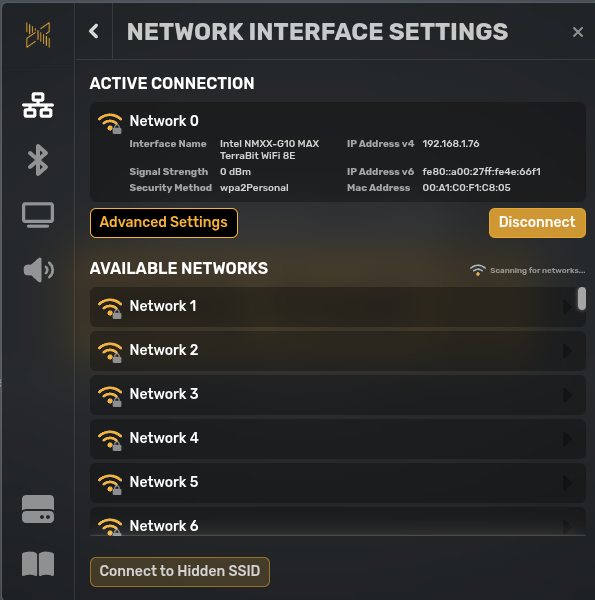
| Function | Description | Use Case |
|---|---|---|
| Available Networks | List of detected wireless networks within radio range | Network selection |
| Advanced Settings | Extended wireless configuration parameters | WPA Enterprise, hidden SSIDs, static IP |
| Network Disconnection | Terminate current wireless connection | Switch networks or troubleshoot |
Network selection triggers security and authentication configuration:
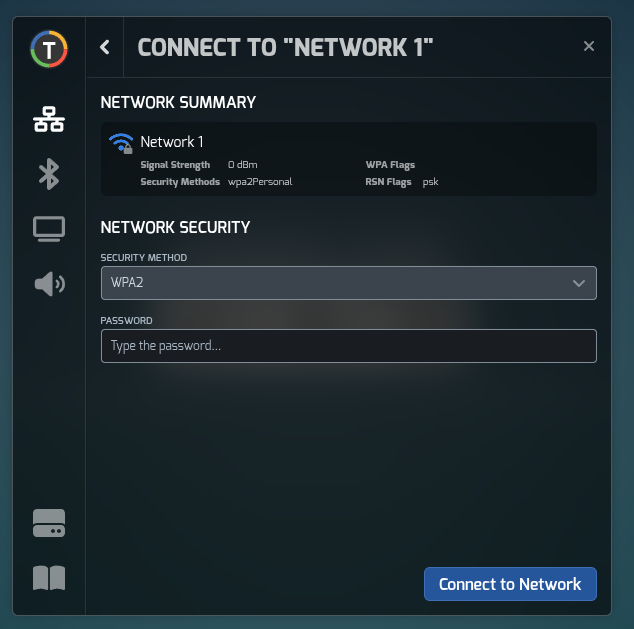
Security settings:
- Network security protocol (WPA2, WPA3, WPA Enterprise)
- Password or passphrase entry
- Certificate-based authentication (for Enterprise networks)
Advanced wireless settings interface:
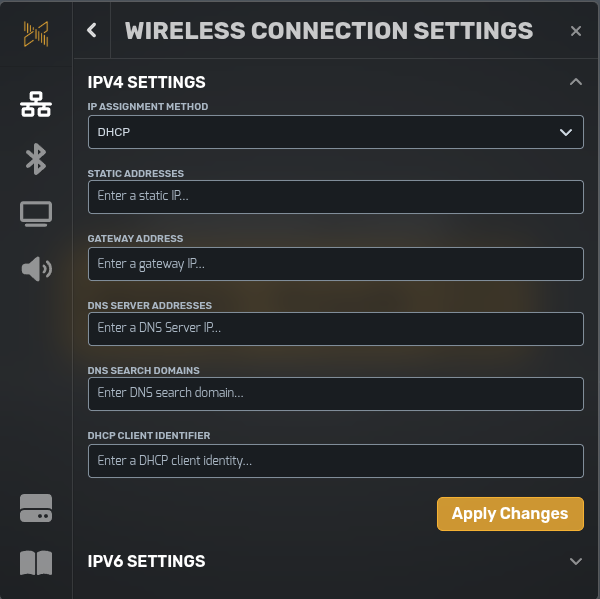
Advanced parameters:
- Static IP configuration
- DNS server customization
- Proxy settings
- Hidden SSID manual entry
- WPA Enterprise credentials (RADIUS, 802.1X)
Wired Network Configuration
Wired connection interface configures Ethernet connectivity with advanced settings:
Configuration options:
- DHCP (automatic IP assignment)
- Static IP address, subnet mask, gateway
- DNS server specification
- VLAN tagging (for network-segmented environments)
Wired configuration applies to devices with Ethernet ports. Some devices (tablets, compact players) lack Ethernet and require wireless connectivity.
Bluetooth Pairing
Bluetooth interface discovers and pairs with nearby Bluetooth-enabled devices:
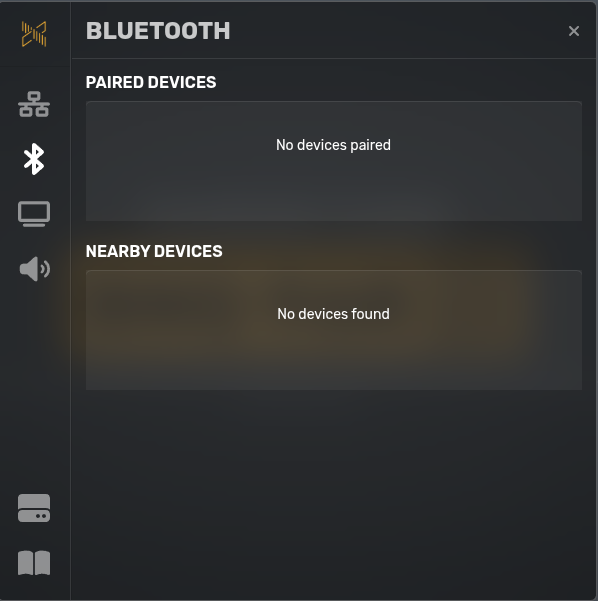
Pairing capabilities:
- Bluetooth keyboard and mouse input devices
- Bluetooth speakers and audio output
- Bluetooth sensors (for IoT applications)
Bluetooth pairing persists across device reboots. Paired devices automatically reconnect when in range.
Display Configuration
Display interface controls visual output parameters:

| Setting | Options | Impact |
|---|---|---|
| Resolution | Display native resolution or custom dimensions | Content clarity and screen fit |
| Rotation | 0°, 90°, 180°, 270° | Portrait vs. landscape orientation |
| Display Selection | Primary display or multi-monitor assignment | Multi-screen configurations |
Resolution considerations:
- Native resolution provides best clarity
- Custom resolutions support non-standard displays or video walls
- Mismatched resolution causes scaling artifacts
Rotation use cases:
- 90° or 270° for portrait-oriented signage
- 180° for ceiling-mounted or inverted displays
- 0° (default) for standard landscape orientation
Audio Configuration
Audio interface controls sound output routing and levels:

Audio settings:
- Output Device: Speaker selection (HDMI audio, analog out, USB audio, Bluetooth speakers)
- Volume: System-level volume control (0-100%)
HDMI audio output routes sound through display speakers. Analog or USB audio output uses dedicated audio hardware. Bluetooth audio routes to paired Bluetooth speakers.
Volume configuration sets system-level default. Application-specific volume controls (video playback, web content) may override system volume.
Device Settings
Device settings configure system-level parameters:

| Setting | Purpose | Impact |
|---|---|---|
| Date, Time, Time Zone | System clock configuration | Log timestamps, scheduled content |
| Device Environment | TelemetryOS environment selection | Production, staging, development |
| Player Channel | Software update channel | Stable, beta, or specific version |
| Reset Device | Factory reset functionality | Troubleshooting and reprovisioning |
Time synchronization:
- Devices synchronize time via NTP when connected to internet
- Manual time setting available for air-gapped environments
- Time zone determines local time display in content
Device Environment:
- Production: Standard TelemetryOS cloud
- Staging: Testing environment
- Development: Development/testing instance
- Custom: Private cloud or on-premise instance
Player Channel:
- Stable: Production-ready releases
- Beta: Early access to new features
- Specific version: Pin to particular TelemetryOS version
System Information
System Information screen displays version details for diagnostics:
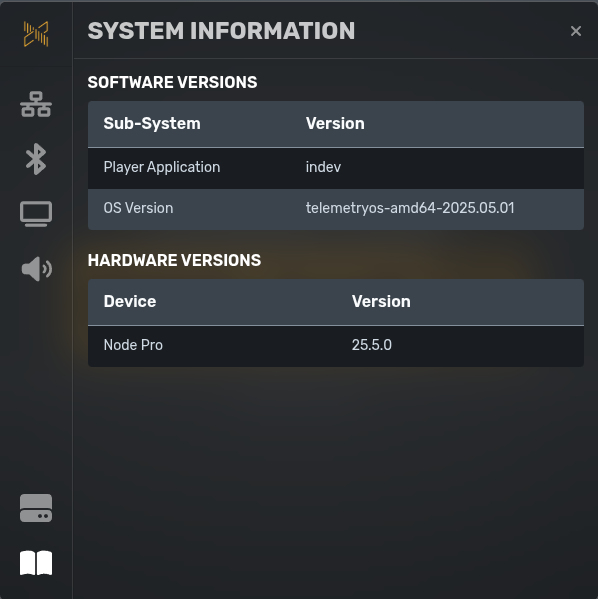
Version information:
- Player version: TelemetryOS player software version
- OS version: Operating system version (TelemetryOS, ChromeOS, etc.)
- Hardware model: Device model identifier
- Serial number: Unique device identifier
Version information assists troubleshooting and feature compatibility verification. Support teams use version details for diagnostics and update recommendations.
Setup Screen Access
Setup screens appear automatically during initial device provisioning. After pairing with TelemetryOS, setup screens become accessible through:
- Interactive menu (devices with keyboards): Press
Ctrl+Shift+Sduring playback - Device administration (remote access): Open Interactive Menu via web interface
Setup screen changes take effect immediately. Network configuration changes may briefly interrupt connectivity during application.
Common Configuration Patterns
Wireless corporate network: WPA Enterprise with RADIUS authentication, static IP, custom DNS
Wired simple setup: DHCP automatic configuration, default display settings, stable player channel
Portrait display: 1080x1920 resolution, 90° rotation, HDMI audio, automatic time zone
Multi-display video wall: Custom resolution per display, specific display selection, wired connectivity for reliability
Testing environment: Beta player channel, development environment, manual time setting, verbose logging
Air-gapped installation: Static IP, manual time/date, local DNS, stable player channel
Configuration Specifications
Setup screens configure during initial provisioning (before TelemetryOS pairing) or via Interactive Menu (after pairing).
Required Configuration
- Network connectivity (wireless or wired)
- Display output (resolution and orientation)
Optional Configuration
- Advanced network settings (static IP, DNS, proxy)
- Bluetooth device pairing
- Audio output device and volume
- Time zone and system time
- Player channel and environment
- Custom display resolution
Limitations
- Setup screens require local device access (physical device or remote desktop)
- Network configuration changes may temporarily disconnect device
- Display resolution limited by hardware capabilities
- Bluetooth pairing depends on device Bluetooth support
- Player channel changes trigger software update (may require restart)
- Environment changes require device reprovisioning
- Factory reset erases all configuration and pairing (cannot be undone)
Updated 12 days ago